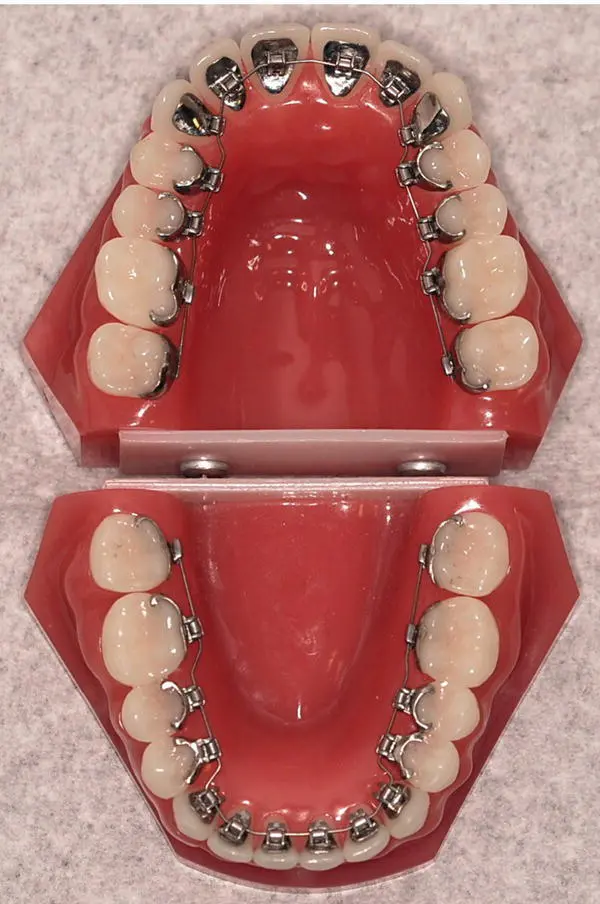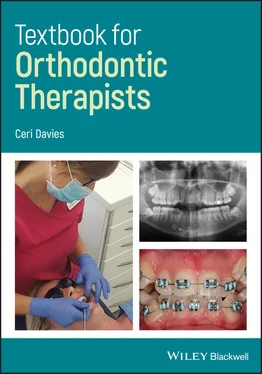Ignores individual biological variation.
Increased friction has implications and increases anchorage considerations.
Peter Kelsing:
Developed the tip edge appliance in 1986.
Is an American orthodontist, born in La Porte, Indiana, and is the son of Harold Kesling who was also an orthodontist.
Peter also has one son called Chris Kesling who followed in both his father’s and grandfather’s footsteps and works as an orthodontist at the same practice in Westville, Indiana.
Tip edge appliance:
Developed based on the best features of the Begg appliance (round wires, light forces) and the preadjusted edgewise appliance (detailed finishing).
There are three stages of treatment when using this appliance:Stage 1: Align teeth, correct incisor and molar relationship, crossbites and rotations.Stage 2: Start space closure and maintain stage 1 corrections.Stage 3: Correct inclination of teeth.
Each bracket incorporates the inbuilt prescriptions (in and out, tip, torque).
Round archwires are used for the initial tipping and aligning stage and the later stages have the use of the rectangular archwires, which gives more control over tooth movement and helps with the final detailing.
To ensure full engagement, the archwire is engaged into the bracket slot by the use of elastomeric modules or metal ligatures.
1.6 Self‐ligating Appliance
Self‐ligating appliance ( Figure 1.6):
Developed in 1990.
Became very popular among non‐extraction orthodontists and was initially used on non‐extraction cases.
Self‐ligating brackets incorporate a door/clip which ensures full engagement, and holds the archwire in place within the bracket slot. Figure 1.6 Self‐ligating appliance.
There are two types of self‐ligating bracket:Passive: has a slide mechanism which is passive and places no active force on the archwire.Active: Places an active force on the archwire.
Once engagement of the archwire has been made by the door/clip, the archwire is free to move in brackets, making the appliance free‐sliding.
The circumference of the arch is increased, due to space being created on expansion to align teeth, leading to the wide smiles we see today.
Inter‐arch elastics are used in conjunction with self‐ligating appliances to help improve the patient’s occlusion.
Self‐ligating appliances are known to reduce chairside time as adjustments are quicker.
Different types of torque are available within the brackets, such as standard/high/low torque.
Manufacturers claim that self‐ligating appliances produce lower friction.
Examples of self‐ligating systems:
Damon® – 3, 3mx, Q, Clear (Ormco Corporation, Orange, CA, USA).
Clarity™ SL (3M, St Paul, MN, USA).
Harmony (ASO International, Tokyo, Japan).
SmartClip™ (3M).
SPEED System™ (Haspeler Orthodontics, Cambridge, ON, Canada).
In‐Ovation C® (Dentsply Sirona, Woodbridge, ON, Canada).
Advantages:
Provides low friction.
Achieves full archwire engagement.
Quick and easy to use.
No elastomeric modules, which makes oral hygiene easier to control.
Patient can go for longer intervals between appointments.
Disadvantages:
If there is a fault in the door/clip, it means the whole bracket is faulty, therefore a new bracket would be needed.
Appliance can be harder to ligate wire; it is important to make sure the wire is fully engaged in the bracket slot for the door to close.
Higher cost in brackets.
Difficulty in finishing due to the incomplete expression of the archwires.
1.7 Advantages and Disadvantages of all Types of Buccal Appliances
Advantages:
Appliances allow good working access.
Once the clinician is experienced they are easy to work on.
Chairside working time is reduced.
Can achieve excellent finishing and detailing – archwire bending is easier.
Aesthetic brackets and archwires, which are popular with patients.
Quicker treatment time as opposed to lingual appliances.
Disadvantages:
Poor aesthetics as they are on the labial/buccal surface of teeth.
Any decalcification occurring from treatment will be visible.
Aesthetic brackets can fracture during debonding.
Lingual appliances ( Figure 1.7):
First developed in the 1970s in the USA.
The brackets are bonded onto the palatal/lingual surface of the upper and lower arches.
Lingual appliances use preadjusted ribbonwise brackets, which are thicker vertically than horizontally.
All brackets and archwires are custom made to reduce speech problems and tongue irritation and to help improve finishing.
Custom‐made brackets are good as they can be rebonded directly back on if they debond during treatment; however, if a bracket is lost, new ones have to be specially ordered.
Brackets come in a jig and are all bonded together at once (indirect bonding). It is important to keep the bracket in the jig, because there can be undesired tooth movement if it comes out or is bonded directly to the tooth without a jig.
Lingual appliances can also come in a self‐ligating form.
Advantages:
Good aesthetics.
Decalcification less likely to occur with lingual appliances compared to labial appliances; however, if present it will not be visible.
Upper anterior brackets can act as a bite plane, which is good for treating overbites (flat anterior bite plane or FABP).
Disadvantages:
Can affect patient’s speech.
Much more ulceration can appear.
Discomfort to patient’s tongue.
Clinically demanding on clinicians.
Inter‐bracket span is reduced.
Increased chairside time.
Finishing and detailing are difficult to achieve due to the reduced inter‐bracket span, and archwire bending can be made difficult.
Indirect bonding of brackets or debonding of brackets can result in poor positioning if not bonded back in the correct position.
Increased cost.
Longer treatment time.

Figure 1.7 Typhodont showing Harmony lingual appliance.
Patient assessment is very important prior to orthodontic treatment. Including radiographs and study models, each patient should have an orthodontic assessment. This assessment looks at the patient's skeletal features and malocclusion. Assessment must be done to help the orthodontist assess the need for treatment and create a treatment plan that is appropriate to the patient.
A patient assessment is done in two ways:
Extra‐oral assessment
Intra‐oral assessment.
The three planes of space are used when carrying out the assessments. The extra‐oral assessment refers to outside the mouth, whereas the intra‐oral looks inside the mouth. The two assessments consider the following:
Extra‐oral assessment: assesses the facial profile.
Intra‐oral assessment: assesses the position of the upper and lower dentition.
2.1 The Three Planes of Space
The three planes of space we refer to in orthodontics are:
Antero‐posterior plane (AP): assesses the patient front to back.
Vertical plane: assesses the patient up and down.
Transverse (horizontal) plane: assesses the patient side to side.
2.2 Extra‐Oral Assessment
There are four stages to carrying out an extra‐oral assessment. The first three look at the three planes of space, whereas the fourth stage concentrates on the lower third of the face.
Читать дальше













